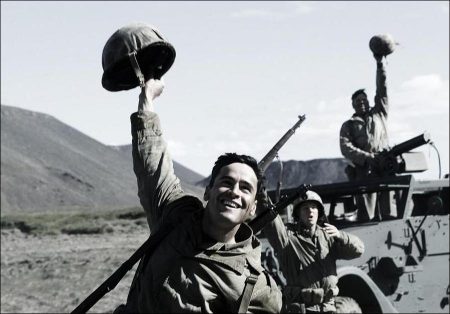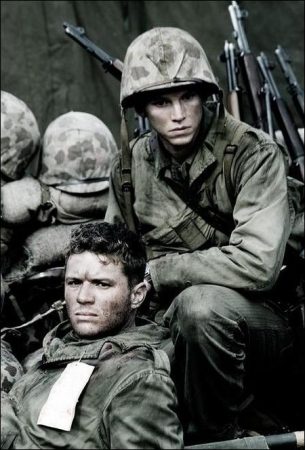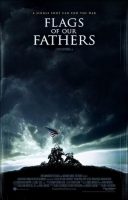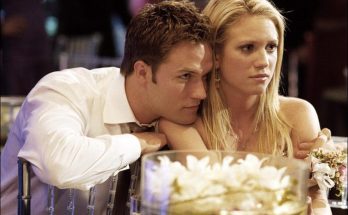Tagline: A single shot can end the war.
Flags of Our Fathers is based on James Bradley’s book “Flags of Our Fathers: Heroes of Iwo Jima”. The Battle of Iwo Jima, which took place in winter 1945, was a turning point in the Pacific theater. About 6,000 Americans died and 17,000 were wounded during the Battle of Iwo Jima. The battle produced one of the most enduring images of WWII: a photograph of U.S. servicemen raising an U.S. flag on the flank of Mount Suribachi, the island’s commanding high point.
From Academy Award-winning director Clint Eastwood (“Million Dollar Baby,” “Unforgiven”) comes the World War II drama “Flags of Our Fathers,” produced by Eastwood and Academy Award winner Steven Spielberg .
February 1945. Even as victory in Europe was finally within reach, the war in the Pacific raged on. One of the most crucial and bloodiest battles of the war was the struggle for the island of Iwo Jima, which culminated with what would become one of the most iconic images in history: five Marines and a Navy corpsman raising the American flag on Mount Suribachi.
The inspiring photo capturing that moment became a symbol of victory to a nation that had grown weary of war and made instant heroes of the six American soldiers at the base of the flag, some of whom would die soon after, never knowing that they had been immortalized. But the surviving flag raisers had no interest in being held up as symbols and did not consider themselves heroes; they wanted only to stay on the front with their brothers in arms who were fighting and dying without fanfare or glory.
“Flags of Our Fathers” is based on the bestselling book by James Bradley with Ron Powers, which chronicled the battle of Iwo Jima and the fates of the flag raisers and some of their brothers in Easy Company. Bradley’s father, John “Doc” Bradley, was one of the soldiers pictured raising the flag, although James never knew the full extent of his father’s experiences until after the elder Bradley’s death in 1994.
Production Information
It is the most memorable photograph of World War II, among the greatest pictures ever taken. The winner of the Pulitzer Prize for photography and one of the most reproduced images in the history of photography, the picture has inspired postage stamps, posters, the covers of countless magazines and newspapers, and even the Marine Corps War Memorial in Arlington, Virginia.
“Raising the Flag on Iwo Jima,” a picture taken by Associated Press photographer Joe Rosenthal on February 23, 1945 depicts five Marines and one Navy Corpsman raising the U.S. flag on Mount Suribachi. The image served as a counterpoint for one of the most vicious battles of the war: the fight to take Iwo Jima, a desolate island of black sand barely eight square miles that would prove a tipping point in the Pacific campaign. Lasting more than a month, the fight was a bloody, drawn out conflict that might have turned the American public against the war entirely, had it not been for the photo, which was taken and published five days into the battle.
The photograph made heroes of the men in the picture as the three surviving flag raisers were returned to the U.S. and made into props in the government’s Seventh War Bond Tour. Uncomfortable with their new celebrity, the flag raisers considered the real heroes to be the men who died on Iwo Jima; still, the American public held them up as the best America had to offer, the supermen who conquered the Japanese…
…and then, just as quickly as it had arrived, the glory faded. For two of the surviving flag]raisers, life became a series of compromises and disappointments; for the third, happiness came only by shutting off his war experiences and rarely speaking of them ever again.
About the Film
Eastwood was initially attracted to the project after reading the bestselling book Flags of Our Fathers by James Bradley with Ron Powers. Bradley is the son of John Bradley, the Navy Corpsman in the photograph. Although James Bradley knew that his father had been one of the flag]raisers on Iwo Jima, the war had been a taboo subject in their family. (In fact, James Bradley did not even know that his father had been awarded the Navy Cross, the second highest honor a sailor can receive, for his actions on Iwo Jima.) Eastwood felt that a project that focused on both the events that led up to the flag raising and what happened to the men after they returned home would pose an exciting challenge for him as a director.
“It turned out that DreamWorks had bought the property. I mentioned to Steven Spielberg that I liked the property very much, and I just left it hanging in the air like that,” says Eastwood. “Then, a couple of years ago, I ran into Steven at a function and he said, ‘Why don’t you come over and do the project? You direct it and I’ll produce it with you.’ So I said, ‘OK, I’ll do that.’
Spielberg – who made a memorable WWII film with “Saving Private Ryan,” for which he won the Oscar for best director – says that Eastwood’s remarkable career and filmmaking principles left no question that the film was in good hands. “Over the three and a half decades since I first met Clint, it has been wonderful to see the range, confidence, and mastery of his work keep growing,” he says. “His body of work – in the sheer variety of its themes and moods – has no comparisons in the modern movie world. It has been equally wonderful to see the world offer Clint its acclaim and affection for his work and recognize in Clint an artistry that no one has ever heard him claim for himself. Maybe that’s the most wonderful thing of all about this story – watching Clint remain the same man he’s always been; that is to say, totally unimpressed with himself.
‘Lessness is bestness’ he likes to say and that applies especially to his own ego and his dependence on trust. Trust – in his cast, in his crew—reflects Clint’s own trust in himself, in his own instincts, whether he’s casting or choosing material or setting up a shot.”
The screenplay is by William Broyles, Jr. and Paul Haggis from James Bradley’s book. The book was published in 2000 by Bantam Books and became nothing short of a sensation. It spent 46 weeks on the New York Times Best Sellers list, including six weeks at #1.
Bradley was inspired to write the book after his father’s death; realizing that he knew only that his father had been a flag]raiser and nothing else, he began interviewing the families of the other flag]raisers. “I never set out to write a book – I set out to find out why my dad was silent,” says Bradley. “I decided to write the book when I realized that everyone knows the photo, but nobody knows the story.”
In the end, Bradley says, his goal was to break down the hero myths about the men in the picture. According to Bradley, because of the way the photo is shot, with every man’s face obscured, it is easy to think of the subjects of the picture as supermen; instead, of course, they’re everyday people. “To me, the beauty of the photo is that they are us – six ordinary Americans, doing their duty.”
Three of those ordinary American boys would die performing their duty in the days after the photo was taken. For the other three, life became a series of challenges and disappointments.
“It’s interesting to find out what happened to these guys – how they got home, what happened to them on the bond tour, and the effect that the war and the tour had on them,” says Eastwood. “It left all of them confused; two of them, especially, led very tough lives.”
Ryan Phillippe stars as Doc Bradley, the Navy Corpsman who was called upon to help the Marines raise the flag. Of the three surviving flag raisers, only Bradley was able to piece together a successful life after the war – and even he was plagued by nightmares and hallucinations. “When all you have is the picture, you bring all of your preconceptions with you,” says Ryan Phillippe.
“Of course we see these men as heroes, because we need to put people on pedestals, to make them stand for something. This film is a chance to see things from the other side, how people who did heroic things see themselves.” Jesse Bradford plays Rene Gagnon. With doubts about his fighting abilities, Gagnon was pressed into service as a runner and was lucky enough to have been the man ordered to bring the flag to the top of Mt. Suribachi. Gagnon – unlike Bradley and Hayes – attempted to cash in on his newfound celebrity, but the experience left him bitter. The jobs he had been promised by zealous men in the government and business didn’t materialize, and he worked menial jobs until his death in 1979.
Bradford says, “This was a time before celebrity culture, but these three guys really did become famous in a way that hadn’t really happened before. For 6 months or so, these guys were three of the most famous people in America. They went from a war zone – shooting at other human beings and watching their friends die – to a situation where everybody knew their name. That had to be difficult to reconcile.”
Adam Beach, previously the star of “Smoke Signals” and “Windtalkers,” plays Ira Hayes. Hayes’s story is a tragic one; unable to get over the horrors of war and uncomfortable with what he felt was an undeserved position as a national hero, Hayes descended into alcoholism and found himself in and out of jail. In 1955, he died of exposure. His heartbreaking story was told in song, “The Ballad of Ira Hayes,” written by Peter LaFarge and performed by Johnny Cash, Bob Dylan, and others, and on film, in 1961’s “The Outsider,” starring Tony Curtis as Hayes. “Though ‘The Outsider’ wasn’t a bad little film, we were aware from the very beginning that we wanted a real Native American to play Ira Hayes,” says Eastwood.
Beach notes that despite his position as one of the industry’s leading Native American actors, he is often asked to play a role as “the stereotypical stoic Indian,” he says. “Ira’s not like that – this is a complex human being with real emotions. My favorite scene in the movie is when Ira meets President Truman – I think it’s important for the younger generation of Native Americans to see that we have our heroes. We did our part to make America what it is today.”
The story of the flag]raisers has inspired countless tributes over the years; in 1949, John Wayne starred in “The Sands of Iwo Jima,” a fictionalized account of the battle. Of course, “Flags of Our Fathers” delves deeper into the story than ever before; what’s more, it was the opportunity to portray a multifaceted drama that first attracted Eastwood to the project. “Especially for someone 19, 20 years old, these characters are experiencing a very complex set of emotions,” says Eastwood. “I think they all felt that they had been taken out of the war and left a job undone. Still, they also felt they had a different job to do and they did it.”
About the Photograph
“Everybody has their own idea about what makes the photograph special,” says Clint Eastwood. “On one level, it’s guys doing some work – raising a pole – and that may be how the six guys in the picture saw it themselves. But in 1945, it symbolized the war effort.”
The famous picture, taken by Associated Press photographer Joe Rosenthal, actually depicts the second flag raising on Iwo Jima. After the invasion on the February 19th, the Marine fifth division began the attempt to capture Mt. Suribachi. By the fifth day, the American forces had suffered many casualties, but had also forced the Japanese to retreat into caves on the island.
That morning, they raised a small American flag on top of the mountain as a signal that it had fallen. As the story goes, the secretary of the Navy, who wanted it as a souvenir for himself, demanded the flag. The marines were ordered to take it down and Marine runner Rene Gagnon was instructed to carry up another, larger flag, to raise in its place.
Gagnon climbed to top of the mountain, where he found Marines Michael Strank, Harlon Block, Ira Hayes, and Franklin Sousley, who had spent the morning laying a telephone line to the top of the mountain. They needed to find something large to use for a pole, and found an old Japanese water pipe.
Because of the weight of the pipe, the Marines needed six men to lift it, and asked for the help of Navy Corpsman John Bradley. Rosenthal, aware of what was going on, put down his camera and began piling rocks that he could stand on to gain a better vantagepoint. Realizing he was about to miss his shot, he picked up his camera, and pressed the shutter release. He did not use the viewfinder. One four]hundredth of a second later, history was made.
“When you get a picture like that, you don’t come away saying you got a great shot,” wrote Rosenthal in Collier’s magazine ten years later. “You don’t know.”
Indeed, it would be some time before Rosenthal knew he’d captured something lasting, as he had sent his film to Guam to be developed. When AP photo editor John Bodkin saw the picture, he immediately radiophotoed the picture to New York. Seventeen and one]half hours after Rosenthal snapped the picture, it was on the AP wire – an astonishingly fast turnaround time. It would be five or six days before Rosenthal would see his now]famous photograph.
Like the surviving men in his picture, Rosenthal became a celebrity. Initially classified 4-F by the Selective Service (and thus not eligible for military duty) because of poor eyesight, Rosenthal was reclassified 2-AF (essential deferment) because – according to a Time magazine article from the time – the picture entitled him “to a classification better than 4-F.”
Still, there was some controversy. A few days after the now]famous photo hit the front pages of newspapers across the country, a reporter asked Rosenthal if he had staged the shot. Rosenthal, thinking that the reporter was referring to a different, obviously posed picture of Marines cheering with the flag, said, “Sure.”
The fact that the picture chronicles the second flag raising of the day also added to the confusion, and for the next fifty years, Rosenthal was accused of manufacturing an image that he’d seen earlier.
To help handle requests for interviews and appearances, the AP set up a “Rosenthal desk.” Rosenthal met President Truman, received a bonus of a year’s salary in War Bonds from the AP, and won the Pulitzer Prize.
Rosenthal died in August 2006 at the age of 94. In an obituary in the New York Times, Richard Goldstein praised the photographer’s most famous work, writing, “The triumphant portrait, representing the first seizure by American troops of territory governed as part of the Japanese homeland, struck a tremendous emotional chord on the home front and resonated deeply as a symbol of the diversity in American life.”
For Rosenthal, it was clear who the heroes were. In the Collier’s article, he commented, “…[O]f all the elements that went into the making of this picture, the part I played was the least important. To get that flag up there, America’s fighting men had to die on that island and on other islands and off the shores and in the air. What difference does it make who took the picture? I took it, but the Marines took Iwo Jima.”
Flags of Our Fathers (2006)
Directed by: Clint Eastwood
Starring: Ryan Phillippe, Jesse Bradford, Adam Beach, Paul Walker, Jamie Bell, Barry Pepper, John Benjamin Hickey, Melanie Lynskey, Neal McDonough, Tom McCarthy, Judith Ivey
Screenplay by: Paul Haggis
Production Design by: Henry Bumstead
Cinematography by: Tom Stern
Film Editing by: Joel Cox
Costume Design by: Deborah Hopper
Set Decoration by: Richard C. Goddard
Art Direction by: Jack G. Taylor Jr.
Music by: Clint Eastwood
MPAA Rating: R for sequences of graphic war violence and carnage, and for language.
Distributed by: DreamWorks Pictures
Release Date: October 20, 2006
Views: 85






